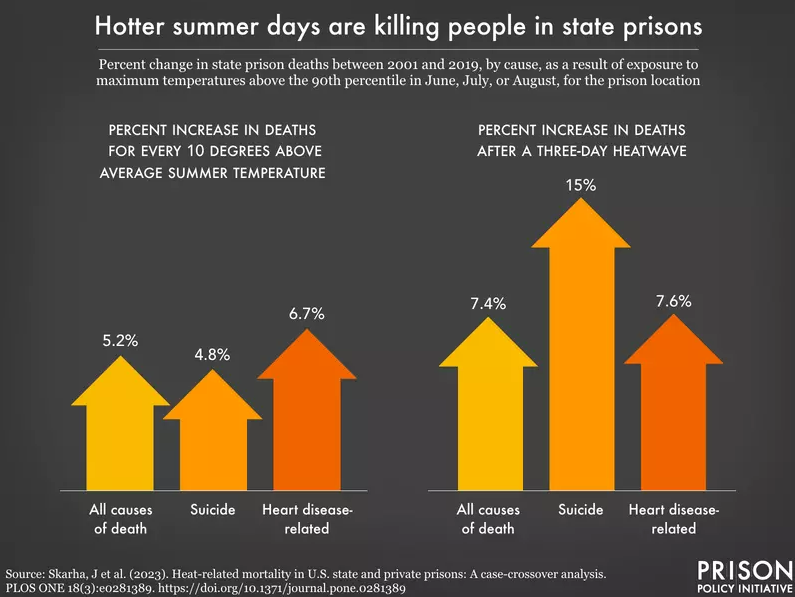Report: What Does Climate Change Look Like for People In Prison?
Extreme heat is especially harmful to incarcerated persons

In meteorological terms, a 100-year event is meant to describe a weather event of a size that will be equaled or exceeded on average once every 100 years. Yet these so-called 100-year events are now commonplace and occurring much more frequently due to climate change. States across the American South and Southwest are experiencing record high temperatures on a daily basis. The Northeast has been drenched in frequent rainfall events, leading to significant flash flooding. Prisons and jails nationwide aren’t insulated from these events, yet we rarely see how bad the conditions are for the millions of people locked within them.
A recent briefing from Prison Policy Initiative highlights new epidemiological evidence confirming that heat and death are linked in prisons nationwide, and explain why the climate-change-induced plight of people in prisons deserves urgent action.
Certainly not unexpected, unusual heat was associated with higher overall mortality. The researchers found for every 10 degree increase above the prison location’s mean summer temperature, nearly 5% of deaths (from all causes) occurring there could be attributed to the heat. Even the days following a hotter-than-average day were associated with deaths, although the risk of heat-related death declined, suggesting that mitigating heat right away is crucial.
Further, an extreme heat day (one that falls within the hottest 10% of days for a particular location) was associated with a 3.5% increase in deaths. These extremely hot days had a delayed effect on suicides, which increased by 23% over the three days that followed. As if prison environments weren’t already damaging enough to mental health, the oppressive heat and a prison’s failure to provide relief from it can drive someone into unbearable distress.
Even though judges in multiple states have ruled that subjecting incarcerated people to extreme temperatures is unconstitutional, they haven’t mandated any relief measures. Public opposition to providing “comfortable” carceral spaces has further compelled prison officials to do nothing about this life-or-death issue. Even the mild relief of a fan or a towel can be hard to come by in prisons. These items might be available, though unaffordable, through a commissary. For example, in one federal prison, where most people make less than fifty cents an hour, a fan costs $30.70. In Oregon, where a heat wave brought 100-plus degree days in 2021, one prison offered special “cooling” towels for $18, representing a markup of almost double the cost.
Even though incarcerated people regularly organize for their own survival needs, they face an especially daunting challenge developing strategies to acclimate to the growing climate crisis. The deck that is stacked against them grows exponentially as our natural surroundings become more inhospitable. Further, the impacts of climate change on incarcerated populations will ripple out to surrounding communities, making this an issue we should all care about. Places of confinement and the people inside them must be part of any effort to reduce the harms of climate change.
You can read the full epidemiological study "Heat-related mortality in U.S. state and private prisons: A case-crossover analysis" at PLOS, a nonprofit, Open Access publisher empowering researchers to accelerate progress in science and medicine by leading a transformation in research communication. For a narrative briefing on the report by Prison Policy Initiative, visit "Heat, floods, pests, disease, and death: What climate change means for people in prison."










